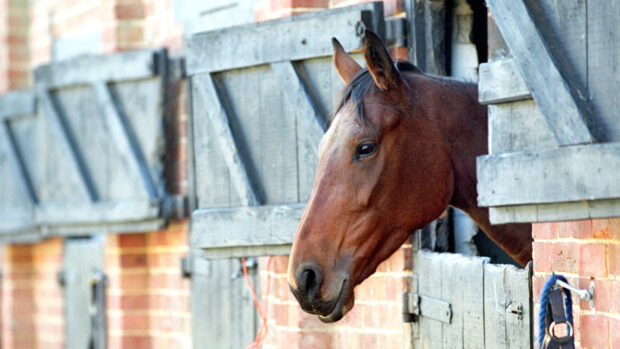Stable vices are examples of “stereotypies” – sequences of repeated behaviour with no apparent purpose or function. They appear to originate from a need-related drive, which develops in an environment with inadequate opportunities for satisfying that need.
They illustrate a horse’s inability to cope and should, perhaps, be considered indicators of poor welfare rather than a vice. Once established, stereotypic behaviour may become a need in itself, a coping mechanism to dissipate anxiety.
Environmental issues
Steriotypies are variations on “normal” behaviour, developing as a result of a deficient environment, in which movement, diet, and social contact are restricted.A behavioural sequence consists of two phases:
- appetitive: the horse is motivated to perform an act (eg courtship)
- consummatory: the act is completed, so eliminating the initial motivation (eg mating).
If the consummatory phase cannot be reached, the horse returns to the original sequence and begins again. Eventually, the initial behavioural act becomes a fixed pattern, which is refined further until it barely resembles normal behaviour.
Once established, stereotypies become almost impossible to eradicate, even if the original stress factors are addressed.
Contributing factors
A combination of genetics and environmental factors influence behaviour.
Genetics:
Horses can tolerate stress, frustration and boredom to a certain level, dependent on the genetic make-up of the individual, beyond which behavioural abnormalities may appear. While stable vices are not directly passed on, temperament and, therefore, the ability to deal with stress, is an inherited trait. Thus, stereotypies are linked with certain bloodlines and most horses showing one kind of vice will have relatives showing another.
Management:
This has the greatest influence on behaviour.
- Diet and feeding: a high concentrate, low volume, low roughage diet meets the nutritional needs faster than it satisfies the horse’s drive to carry out the physical act of eating, which can predispose it to oral-based stereotypies. Studies show an increased risk if less than 6-8 kg/day of forage is available. Daily grazing is essential.
- Insufficient socialstimulation: vices are most likely to happen when the horse is stabled in complete isolation, less likely with other horses in view only or where it can contact other horses, even less when it is kept with others in a barn and least likely to happen when the horse is kept with others at grass.
- Insufficient space/inadequate daily exercise: surveys show that endurance horses seldom crib, while dressage and racehorses do, as they spend more time confined. Stereotypies are rare in horses kept at grass.
- Pawing: when the horse can hear feed being prepared, or when a foal is prevented from suckling.
- Copycat behaviour: there is anecdotal “evidence” that horses copy vices from others, but this has never been supported scientifically. In fact, studies show that horses are almost unique in their ability not to be able to mimic their colleagues. It is more likely that the environmental inadequacies which cause one horse to develop a vice have the same effect on others.
- Early experiences: research is currently in progress to establish the effects of orphancy, mare rejection or aggression, early or abrupt weaning, subsequent handling and management and sudden changes in environment on future behavioural problems.
Early findings indicate that the age at weaning and weaning technique are paramount – up to 75% of potential stereotypers show symptoms within one month of weaning.
Dealing with vices
- Cribbing/windsucking: prevent thehorse from grasping surfaces or make it unpleasant by making them too wide or fixing guttering along them. Restrict the horse from arching its neck by:
- a) feeding from the ground, since cribbing is often only done at feed times and the neck cannot be flexed when stretched down;
b) using anti-cribbing straps which cause discomfort when the neck is arched;
c) with surgery – but reports in The Veterinary Record question whether this is appropriate.
- Weaving: anti-weave frames stop the horse from swinging his neck – studies show that less weaving occurs on straw bedding.
- Management measures: if the horse has to be confined in its stable, you should ensure it is stimulated. Groom it several times daily; provide toys, such as horseballs, for unsupervised play; provide a friend, such as a goat.
- Medical methods: mood altering, anti-psychotic and sedative drugs have been used, but any improvement tends to be temporary. Certain drugsblock the “pleasurable” sensation, so removing the positive reinforcement effect, but they are expensive. L-trytophane is a natural substance found in grass hay, which seems to have a calming influence. Prozac has been used in America.
- Other: occasionally, a sudden change in diet can “jolt” a horse out of an early stereotype. It is also worth asking your vet to check that there are no physical causes of discomfort which could be a contributing factor, such as, skin, head, ear and eye pain.
Taking precautions
Given that, once established, stereotypies are almost impossible to reverse, particularly in older horses, and that their presence indicates stress, it is preferable to prevent them in the first place. This can be done by meeting the horse’s needs with good stable management.
- Reassess your weaning technique. Bristol University and Hartpury College are looking into the importance of this by following the progress of different groups of foals. They are comparing thoroughbred foals, destined to go into training at two years old, with future eventers, who are brought on much more slowly. Conclusions will be published next year.
- Raise your youngster to accept change andvariation as normal.
- Reassess management, maximising social contact, available stable area and grazing
- Increase the roughage content of the diet.
- Feed little and often, preferably from the ground, and spread it around – “stall grazing” – to imitate natural foraging.
- Learn to recognise the earliest signs of stress and undesirable behaviour in your horse and start dealing with it immediately.Thanks to Dr Christine Nicol, University of Bristol, and Amanda Waters, Hartpury College, for their help with this article.



